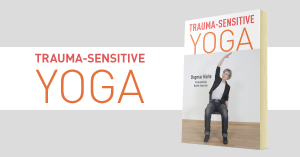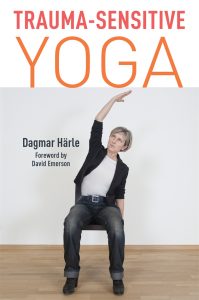In the first part of our Q&A with Dagmar Härle, she discusses her background as a therapist, and how those who have been affected by, or experienced trauma, can improve emotional and physical well-being by participating in ‘trauma-sensitive’ yoga. Click here to read part 2 of the Q&A.
What led you to become a yoga teacher and a trauma therapist? What inspired you to combine the two?
I practiced yoga for many years and eventually I wanted to learn more, and get a deeper understanding of yoga and its philosophy. Therefore, I completed first a kundalini and later a Hatha yoga teachers training course and began teaching yoga classes. It was a perfect combination and helped me to stay balanced and resilient in my work as a coach and therapist, and I learnt mindful tools that I could teach to my clients.
I started trauma therapy training about 15 years ago in somatic experiencing, as I had so many clients who suffered from various symptoms due to trauma (especially trauma beginning in childhood), and I realised that I needed tools to work with clients who had such experiences. My studies of psychotraumatology at the University of Zurich deepened my knowledge and experience of working with those with trauma, but still there was a missing piece. So many patients couldn’t tolerate trauma exposure – they either dissociated or reacted with overwhelming sensations and emotions.
Yoga is a perfect training for the nervous system because there exists calming as well as activating poses and breathing techniques, and it has become obvious to me that yoga is a perfect tool to support patients in self-awareness, self-efficacy and self-control. I started with mindful yoga groups for patients and then I eventually brought yoga into therapy. Going to the Trauma Center and learning from David Emerson and Jenn Turner the TCTSY (Trauma Sensitive Trauma Center Yoga),
I was reassured in my way of using choice as an important way of supporting self-control and self-efficacy to the patients. In practice, for instance, you can execute a side bend with both arms stretched or one arm stretched while the other arm may hang loose or you sit on a chair and bend forward putting your hands on your knees or you go deeper perhaps until your hands reach the floor. It`s always the choice and under control of the patient.
What effect does practising yoga have on emotional and stress responses?
Yoga offers asanas-postures as well as pranayama-breathing techniques to either calm down or activate the nervous system, or in other words, activate either the parasympathetic or the sympathetic branch of our nervous system. Understanding that trauma survivors suffer from both – overwhelming sensations and emotions (sympathetic branch) as well as dissociation and shut down (parasympathetic branch, or more exact, the dorsal vagal part of it) helps to let clients know that they can benefit from yoga because we can offer them the tools for both. Learning the tools to stop dissociation and to be able to handle overwhelming emotions and sensations has an important effect on self-efficiency and self-worth.
Why is it important to connect, or reconnect, the body and the mind after someone has experienced trauma?
Dissociation includes a disconnection with the body. Trauma survivors often have difficulties to sense their body or parts of their body: either parts are numb or simply “not there”. To be able to control stress reaction, one needs to be aware of those reactions in the body in order to calm them down at their very beginning. Not being connected with the one’s body takes away the possibility of controlling overwhelming stress reactions. Dissociation does this even more.
During dissociation, we can say that the “brain goes blank” – what this means is that the cognitive functions are shut down. Someone experiencing dissociation will not be able to process what is going on and will therefore have difficulties distinguishing a dangerous situation from a safe one. This can bring trauma survivors not only in a helpless state, but it also hinders learning because in a panic attack the cognitive functions are shut down. Reconnecting with their body gives trauma survivors the opportunity to control the stress reaction, which leads to better cognitive functions and enables learning to distinguish safe from unsafe situations or persons.
In Trauma Sensitive Yoga, you write that yoga can help clients find safety in their bodies. Why is it important to their recovery to find a level of safety within their bodies?
Emotional reactions take place in the body. Experiencing the body as an unsafe place means it either freezes and doesn’t take one to a safe place and/or is easily overwhelmed with uncontrollable sensations and emotions. It is key that the result of the experience is that you can trust your body.
How can people take the lessons they have learnt from practising yoga and apply the techniques in everyday or stressful situations?
First we work on interoception which means that I support them to sense their body, for example: weight, contact, muscle tension or stretching as well as relaxation after a tension. I offer various possibilities in order to give the patient ideas as to what he or she can possibly sense. The next step is to provide choice. I show variations in a pose, and using their interoceptive capabilities he/she learns eventually to make choices due to their sensations, for example, in a side bend the person can either stretch both arms or let one arm hang loose and by testing both variations in an interoceptive way, the person starts to feel what he or she prefers.
When patients gain experience and are able to make use of their choices, they learn which tools help them to become calmer as well as what helps them to stay connected and end dissociation, which they can then use in everyday stressful situations.
If you would like to read more articles like this and hear the latest news and offers on our books, why not join our mailing list? We can send information by email or post as you prefer, and please also tell us about your areas of interest so we can send the most relevant information. You can unsubscribe at any time.
Trauma-sensitive yoga is a body-based intervention for treating emotional responses to trauma and post-traumatic stress disorder. This book explains why yoga is a useful approach for trauma therapy and shows how to use this method in one-to-one and group settings. It also includes useful examples of non-triggering asanas and breathing exercises.
Click here to read more, or to buy the book.


1 Response